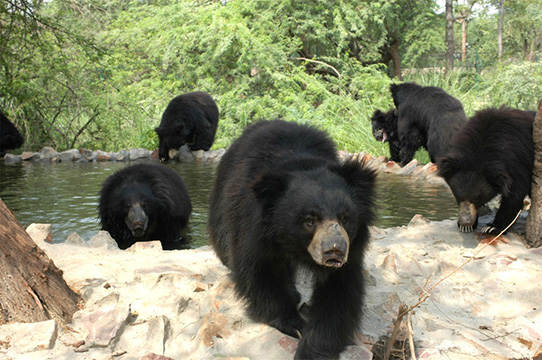India’s Dancing Bears, are an exemplary example of how wildlife can be saved from the grasp of horrendous cultural practices. A Dancing Bear refers to the forceful dancing of a captive sloth bear by its owner. This practice dates back to the Vedic Era (1000-700 BCE) and now forms the identity of the Kalandar Tribe. During the Mughal Era, the Dancing Bear became a prominent form of entertainment for the elite. It was also believed that a Dancing Bear was a good luck charm. Unfortunately, Sloth Bears have fallen victim to the rampant illegal wildlife trade due to this tradition. It is no surprise therefore, that the species is considered “Vulnerable” according to the IUCN Red List.

Efforts have been made to legally abolish this cruel practice. Following the Wildlife Protection Act of 1972, numerous states mandated the possession of ownership certificates of sloth bears. In 1998, the practice was completely banned. However, such policies were of no avail as Dancing Bears. The tradition proved to be a rewarding occupation for the economically reserved Kalandar Tribe. A bear owner would earn up to 500-600 in a single day. A lack of awareness and implementation of the law excaberated the problem further.
The Horrid Lives of India’s Dancing Bears
Sloth Bears cubs are captured as cubs from the wild as a part of the illegal wildlife trade. Their paws are often harvested to make bear paw soup. These bears are sold to the Kalandar society for over $2000. Adult bears are never caught in the wild because of the immense danger they pose to the poachers. In fact, the mother of the bear cub is also killed when the cubs are captured. The traumatic shock faced by the cubs due to separation from their mother can sometimes prove fatal.
For the bears which do survive, a life of torture and deprivation awaits them. To ensure the safety of the owners, the claws of the cubs are either knocked out or clipped while the teeth are removed. Anaesthesia is an imaginary entity in this entire process. Meanwhile, a hot rod is forced through the bear’s snouts in order to permanently puncture it. This puncture allows the anchoring of a rope around the nose, which is used to train and control the bear during dances. Training and disobedience results in beatings with rods and physical threats, all which psychologically damage the orphaned cubs.
Furthermore, the poverty stricken owners of bears lack funds to provide a nutritional diet and water. Blindness by castration and dehydration are amongst the most common causes of death for these unfortunate beasts. Other diseases the bears are susceptible to are oral cancer and gum infection, caused due to the piercing of the gums of the bears. This could prove fatal as bears tend to suck their food through closed mouths. Another disease which has been extensively prevalent in captive bears is tuberculosis. The excessive human interactions of captive bears, allow the rapid spread of such highly contagious pathogens. Tuberculosis infected bears show minimal symptoms and providing bears with anti-tuberculosis medication has proven futile.
Rescuing India’s Dancing Bears

Fortunately, a wildlife NGO by the name of Wildlife SOS is battling hard to end this cruel practice. Comprising three campuses in Agra, Bhopal and Bangalore, this NGO has been rescuing dancing bears since December 2004. In 2009, the last of India’s 628 dancing bears were rescued. All bears have been undergoing rehabilitation since their rescue at the various centers. Releasing these bears is not an option because of the loss of their wild instincts and behavior. For example, a prominent behavioral difference noticed in captive bears, is their lack of climbing abilities, a skill so vital for the avoiding of predation in the wild. Another behavioural alteration in captive bears include the pronounced increase in aggression. Staff at Wildlife SOS have reported excessive roaring and banging against enclosure walls. Such aggression could prove fatal in the wild.
However, the problem of the Dancing Bears does not end with the rescue and rehabilitation of all individual bears. The economic upliftment of the Kalandamar society is of utmost importance to reduce reliance on this industry. Wildlife SOS has also been providing various soft skill training to members of the society. This includes aiding bear owners to establish a formal career and providing communities with sewing machines, hence opening the gateway to the textile industry. In fact, the Wildlife SOS staff also comprises numerous former bear owners. Furthermore, free healthcare was being provided to the Kalmandar villages, alongside providing free educational resources. Such economic upliftment would prevent the need of the tribe to resort back to such cruel practices to earn a livelihood.
Help us Help Them! Think Wildlife Foundation is a non profit organization with various conservation initiatives. Our most prominent campaign is our Caring for Pari intiative. Pari is a rehabilitated elephant at the Wildlife SoS Hospital. 25% of the profits from our store are donated to the elephant hospital for Pari. Other than buying our wonderful merchandise, you could donate directly to our Caring For Pari fundraiser.
